engine CHEVROLET CAMARO 1967 1.G Chassis Workshop Manual
[x] Cancel search | Manufacturer: CHEVROLET, Model Year: 1967, Model line: CAMARO, Model: CHEVROLET CAMARO 1967 1.GPages: 659, PDF Size: 114.24 MB
Page 3 of 659
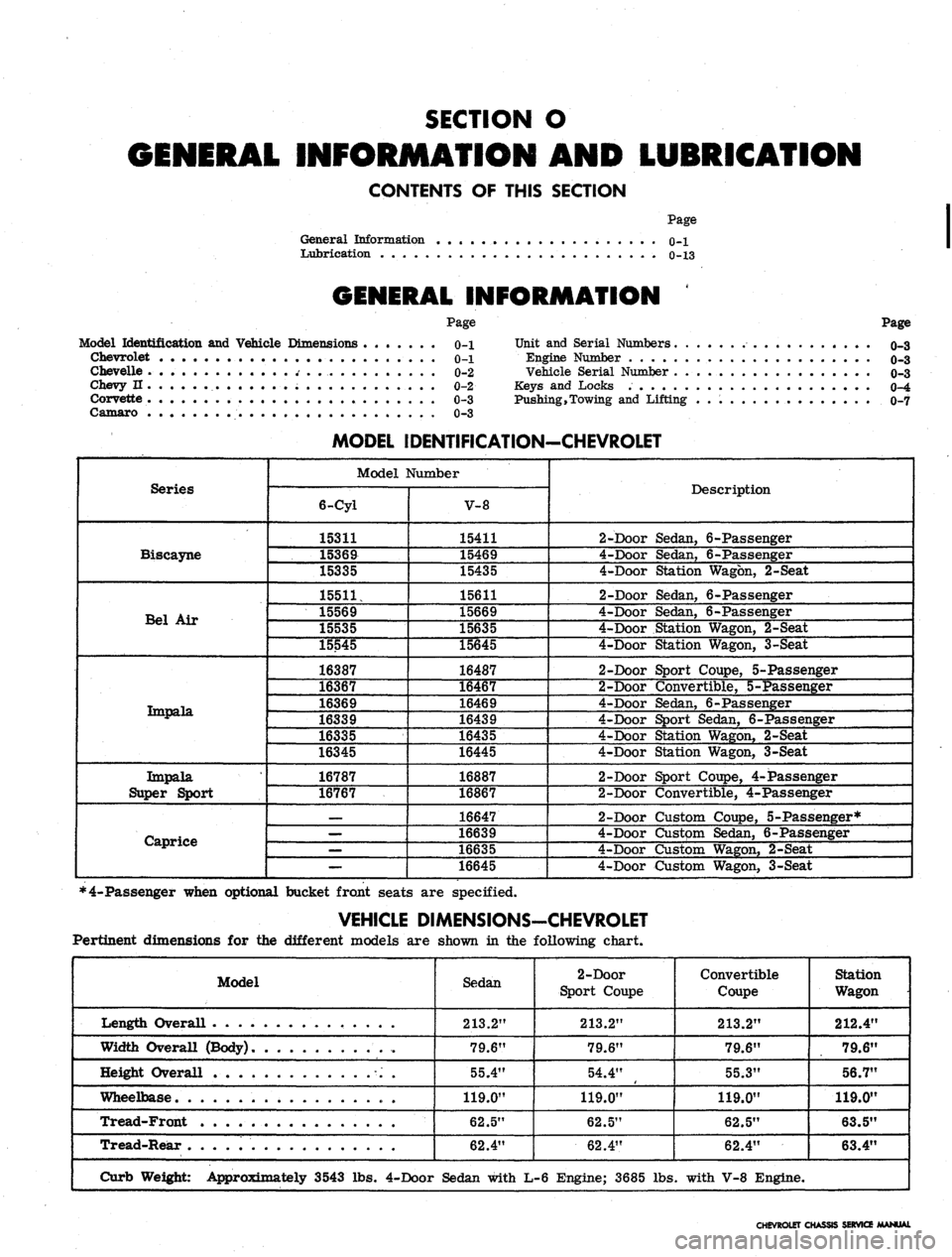
SECTION O
INFORMATION AND LUBRICATION
CONTENTS OF THIS SECTION
Page
General Information o-l
Lubrication 0-13
GENERAL INFORMATION
Model Identification and Vehicle Dimensions
Chevrolet
Chevelle
Chevy n
Corvette
Camaro
Page
0-1
0-1
0-2
0-2
0-3
0-3
Page
Unit and Serial Numbers o-3
Engine Number o-3
Vehicle Serial Number 0r3
Keys and Locks 0-4
Pushing,Towing and Lifting 0-7
Series
Biscayne
Bel Air
Tmpala.
Impala
Super Sport
Caprice
MODEL IDENTIFICATION-CHEVROLET
Model Number
6-Cyl
15311
15369
15335
15511,
15569
15535
15545
16387
16367
16369
16339
16335
16345
16787
16767
—
—
—
—
V-8
15411
15469
15435
15611
15669
15635
15645
16487
16467
16469
16439
16435
16445
16887
16867
16647
16639
16635
16645
Description
2-Door Sedan, 6-Passenger
4-Door Sedan, 6-Passenger
4-Door Station Wagon, 2-Seat
2-Door Sedan, 6-Passenger
4-Door Sedan, 6-Passenger
4-Door Station Wagon, 2-Seat
4-Door Station Wagon, 3-Seat
2-Door Sport Coupe, 5-Passenger
2-Door Convertible, 5-Passenger
4-Door Sedan, 6-Passenger
4-Door Sport Sedan, 6-Passenger
4-Door Station Wagon, 2-Seat
4-Door Station Wagon, 3-Seat
2-Door Sport Coupe, 4-Passenger
2-Door Convertible, 4-Passenger
2-Door Custom Coupe, 5-Passenger*
4-Door Custpm Sedan, 6-Passenger
4-Door Custom Wagon, 2-Seat
4-Door Custom Wagon, 3-Seat
*4-Passenger when optional bucket front seats are specified.
VEHICLE DIMENSIONS-CHEVROLET
Pertinent dimensions for the different models are shown in the following chart.
Model
Length Overall . .
Width Overall (Body)
Height Overall
Wheelbase
Tread-Front
Tread-Rear
Curb Weight: Approximately 3543 lbs.
Sedan
213.2"
79.6"
55.4"
119.0"
62.5"
62.4"
4-Door Sedan with
2-Door
Sport Coupe
213.2"
79.6"
54.4"
119.0"
62.5"
62.4"
L-6 Engine; 3685 lbs
Convertible
Coupe
213.2"
79.6"
55.3"
119.0"
62.5"
62.4"
. with V-8 Engine.
Station
Wagon
212.4"
79.6"
56.7"
119.0"
63.5"
63.4"
CHEVROLET CHASSIS SERVICE MANUAL
Page 4 of 659
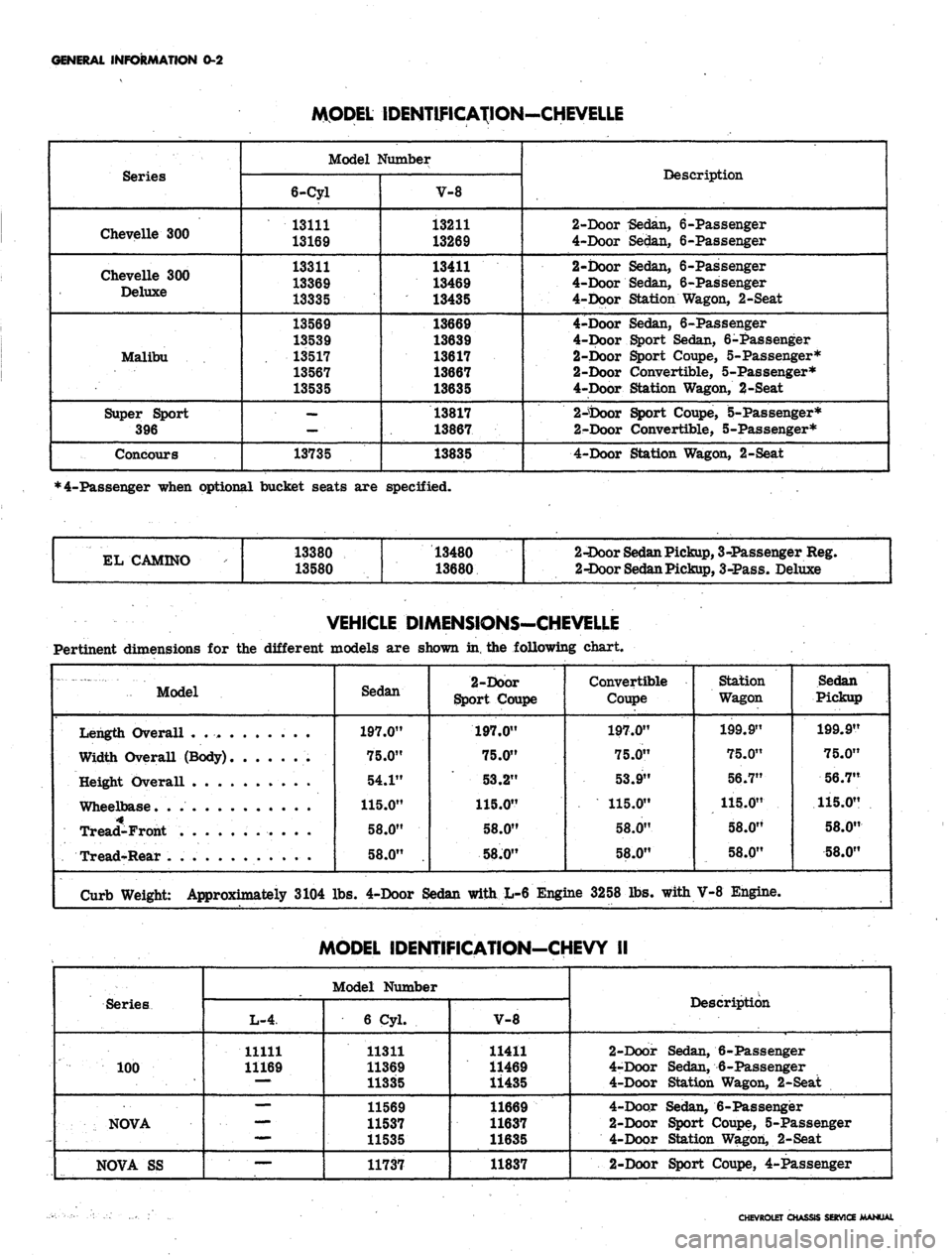
GENERAL INFORMATION 0-2
MODEL IDENTIFICATION-CHEVELLE
Series
Chevelle 300
Chevelle 300
Deluxe
Malibu
Super Sport
396
Concours
Model Number
6-Cyl
13111
13169
13311
13369
13335
13569
13539
13517
13567
13535
—
13735
V-8
13211
13269
13411
13469
13435
13669
13639
13617
13667
13635
13817
13867
13835
Description
2-Door -Sedan, 6-Passenger
4-Door Sedan, 6-Passenger
2-Door Sedan, 6-Passenger
4-Door Sedan, 6-Passenger
4-Door Station Wagon, 2-Seat
4-Door Sedan, 6-Passenger
4-Door Sport Sedan, 6-Passenger
2-Door Sport Coupe, 5-Passenger*
2-Door Convertible, 5-Passenger*
4-Door Station Wagon, 2-Seat
2-tooor Sport Coupe, 5-Passenger*
2-Door Convertible, 5-Passenger*
4-Door Station Wagon, 2-Seat
*4-Passenger when optional bucket seats are specified.
EL CAMINO
13380
13580
13480
13680
2-Door
Sedan
Pickup,
3-Passenger Reg.
2-Door
Sedan
Pickup,
3-Pass. Deluxe
VEHICLE DIMENSIONS-CHEVELLE
Pertinent dimensions for the different models are shown in, the following chart.
Model
Sedan
197.0"
75.0"
54.1"
115.0"
58.0"
58.0"
2-Door
Sport Coupe
197.0"
75.0"
53.2"
115.0"
58.0"
58J0"
Convertible
Coupe
197.0"
75.0"
53.9"
115.0"
58.0"
58.0"
Station
Wagon
199.9"
75.0"
56.7"
115.0"
58.0"
58.0"
Sedan
Pickup
199.9"
75.0"
56.7"
115.0"
58.0"
58.0"
Length Overall .
Width Overall (Body)
Height Overall . . .
Wheelbase. .
Tread-Front
Tread-Rear .
Curb Weight: Approximately 3104 lbs. 4-Door Sedan with L-6 Engine 3258 lbs. with V-8 Engine.
MODEL IDENTIFICATION-CHEVY II
Series
100
NOVA
NOVA SS
Model Number
L-4
11111
11169
mmm.
—
6 Cyl.
11311
11369
11335
11569
11537
11535
11737
V-8
11411
11469
11435
11669
11637
11635
11837
Description
2-Door Sedan, 6-Passenger
4-Door Sedan, 6-Passenger
4-Door Station Wagon, 2-Seat
4-Door Sedan, 6-Passenger
2-Door Sport Coupe, 5-Passenger
4-Door Station Wagon, 2-Seat
2-Door Sport Coupe, 4-Passenger
CHEVROLET CHASSIS SERVICE MANUAL
Page 5 of 659
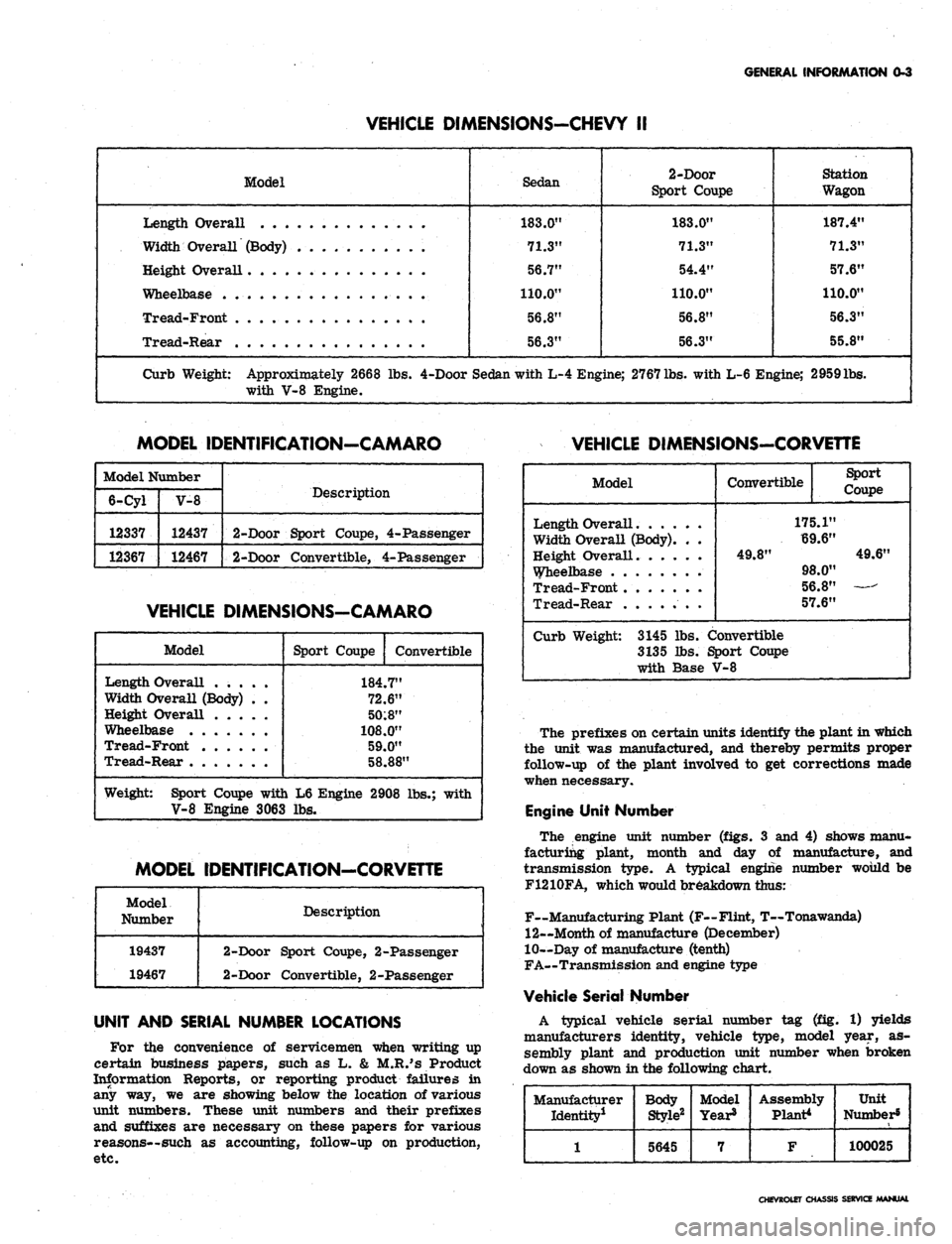
GENERAL INFORMATION 0-3
VEHICLE DIMENSIONS-CHEVY II
Model
Length Overall
Width Overall (Body) . . . .
Height Overall
Wheelbase
Tread-Front
Tread-Rear . . .
Sedan
183.0"
71.3"
56.7"
110.0"
56.8"
56.3"
2-Door
Sport Coupe
183.0"
71.3"
54.4"
110.0"
56.8"
56.3"
Station
Wagon
187.4"
71.3"
57.6"
110.0"
56.3"
55.8"
Curb Weight: Approximately 2668 lbs. 4-Door Sedan with L-4 Engine; 2767
lbs.
with L-6 Engine; 2959lbs.
with V-8 Engine.
MODEL IDENTIFICATION-CAMARO
VEHICLE DIMENSIONS-CORVEnE
Model Number
6-Cyl
12337
12367
V-8
12437
12467
Description
2-Door Sport Coupe, 4-Passenger
2-Door Convertible, 4-Passenger
VEHICLE DIMENSIONS-CAMARO
Model
Length Overall .....
Width Overall (Body) . .
Height Overall
Wheelbase
Tread-Front
Tread-Rear
Sport Coupe
Convertible
184.7"
72.6"
50:8"
108.0"
59.0"
58.88"
Weight: Sport Coupe with L6 Engine 2908 lbs.; with
V-8 Engine 3063 lbs.
MODEL IDENTIFICATION-CORVETTE
Model
Number
19437
19467
Description
2-Door Sport Coupe, 2-Passenger
2-Door Convertible, 2-Passenger
UNIT AND SERIAL NUMBER LOCATIONS
For the convenience of servicemen when writing up
certain business papers, such as L. & M.R.'s Product
Information Reports, or reporting product failures in
any way, we are showing below the location of various
unit numbers. These unit numbers and their prefixes
and suffixes are necessary on these papers for various
reasons—such as accounting, follow-up on production,
etc.
Model
Length Overall
Width Overall (Body). . .
Height Overall.
Wheelbase
Tread-Front
Tread-Rear .
Convertible
Sport
Coupe
175.1"
69.6"
49.8"
49.6"
98.0"
56.8"
57.6"
Curb Weight: 3145 lbs. Convertible
3135 lbs. Sport Coupe
with Base V-8
The prefixes on certain units identify the plant in which
the unit was manufactured, and thereby permits proper
follow-up of the plant involved to get corrections made
when necessary.
Engine Unit Number
The engine unit number (figs. 3 and 4) shows manu-
facturing plant, month and day of manufacture, and
transmission type. A typical engine number would be
F1210FA, which would breakdown thus:
F~Manufacturing Plant (F—Flint, T—Tonawanda)
12—Month of manufacture (December)
10—Day of manufacture (tenth)
FA—Transmission and engine type
Vehicle Serial Number
A typical vehicle serial number tag (fig. 1) yields
manufacturers identity, vehicle type, model year, as-
sembly plant and production unit number when broken
down as shown in the following chart.
Manufacturer
Identity1
1
Body
Style2
5645
Model
Year8
7
Assembly
Plant*
F
Unit
Number5
100025
CHEVROLET CHASSIS SERVICE /MANUAL
Page 6 of 659
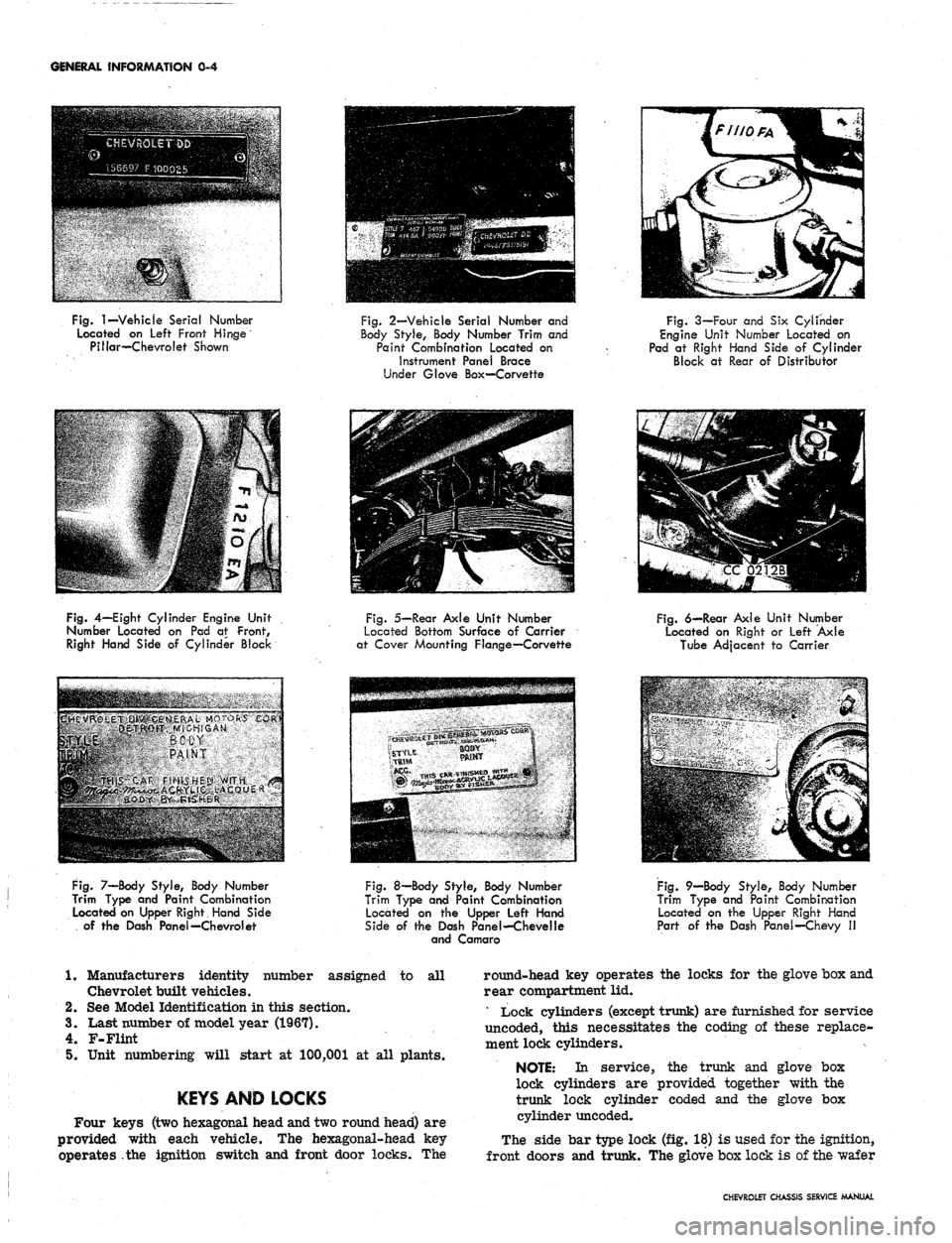
GENERAL INFORMATION 0-4
Fig.
1—Vehicle
Serial Number
Located on Left Front Hinge
Pillar—Chevrolet Shown
Fig.
2—Vehicle Serial Number and
Body Style, Body Number Trim and
Paint Combination Located on
Instrument Panel Brace
Under Glove Box—Corvette
Fig. 3—Four and Six Cylinder
Engine Unit Number Located on
Pad at Right Hand Side of Cylinder
Block at Rear of Distributor
Fig.
4—Eight Cylinder Engine Unit
Number Located on Pad at Front,
Right Hand Side of Cylinder Block
Fig.
5—Rear Axle Unit Number
Located Bottom Surface of Carrier
at Cover Mounting Flange—Corvette
Fig.
6—Rear Axle Unit Number
Located on Right or Left Axle
Tube Adjacent to Carrier
BSHfi^;^
PAINT
HRIKI5"tM>
fIHIsS
HE|St.>MfT*
^^ * *•'"
•<"'
Fig.
7—Body Style, Body Number
Trim Type and Paint Combination
Located on Upper Right Hand Side
of the Dash Panel—Chevrol et
Fig.
8—Body Style, Body Number
Trim Type and Paint Combination
Located on the Upper Left Hand
Side of the Dash Panel—Chevelle
and Camaro
Fig.
9—Body Style, Body Number
Trim Type and Paint Combination
Located on the Upper Right Hand
Part of the Dash Panel—Chevy II
1. Manufacturers identity number assigned to all
Chevrolet built vehicles.
2.
See Model Identification in this section.
3.
Last number of model year (1967).
4.
F-Flint
5.
Unit numbering will start at 100,001 at all plants.
KEYS AND LOCKS
Four keys (two hexagonal head and two round head) are
provided with each vehicle. The hexagonal-head key
operates the ignition switch and front door locks. The
round-head key operates the locks for the glove box and
rear compartment lid.
' Lock cylinders (except trunk) are furnished for service
uncoded, this necessitates the coding of these replace-
ment lock cylinders.
NOTE: In service, the trunk and glove box
lock cylinders are provided together with the
trunk lock cylinder coded and the glove box
cylinder uncoded.
The side bar type lock (fig. 18) is used for the ignition,
front doors and trunk. The glove box lock is of the wafer
CHEVROLET CHASSIS SERVICE MANUAL
Page 9 of 659
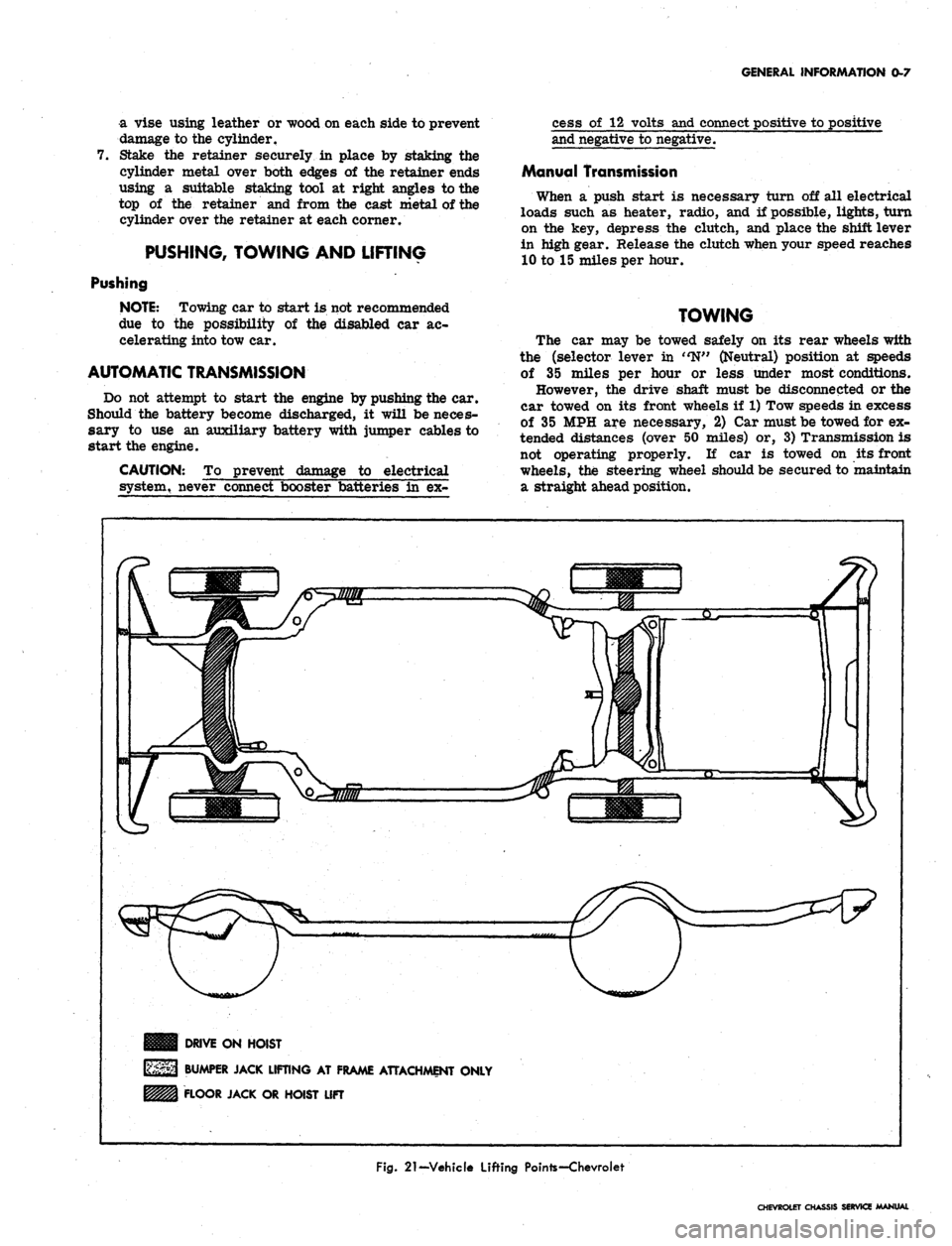
GENERAL INFORMATION 0-7
a vise using leather or wood on each side to prevent
damage to the cylinder,
7. Stake the retainer securely in place by staking the
cylinder metal over both edges of the retainer ends
using a suitable staking tool at right angles to the
top of the retainer and from the cast metal of the
cylinder over the retainer at each corner.
PUSHING, TOWING AND LIFTING
Pushing
NOTE:
Towing car to start is not recommended
due to the possibility of the disabled car ac-
celerating into tow car.
AUTOMATIC TRANSMISSION
Do not attempt to start the engine by pushing the car.
Should the battery become discharged, it will be neces-
sary to use an auxiliary battery with jumper cables to
start the engine.
CAUTION: To prevent damage to electrical
system, never connect booster batteries in ex-
cess of 12 volts and connect positive to positive
and negative to negative.
Manual Transmission
When a push start is necessary turn off all electrical
loads such as heater, radio, and if possible, lights, turn
on the key, depress the clutch, and place the shift lever
in high gear. Release the clutch when your speed reaches
10 to 15 miles per hour.
TOWING
The car may be towed safely on its rear wheels with
the (selector lever in "N" (Neutral) position at speeds
of 35 miles per hour or less under most conditions.
However, the drive shaft must be disconnected or the
car towed on its front wheels if 1) Tow speeds in excess
of 35 MPH are necessary, 2) Car must be towed for ex-
tended distances (over 50 miles) or, 3) Transmission is
not operating properly. If car is towed on its front
wheels, the steering wheel should be secured to maintain
a straight ahead position.
DRIVE ON HOIST
BUMPER JACK LIFTING AT FRAME ATTACHMENT ONLY
FLOOR JACK OR HOIST LIFT
Fig.
21-Vehicle Lifting Pointe-Chevroiet
CHEVROLET CHASSIS SERVICE MANUAL
Page 15 of 659
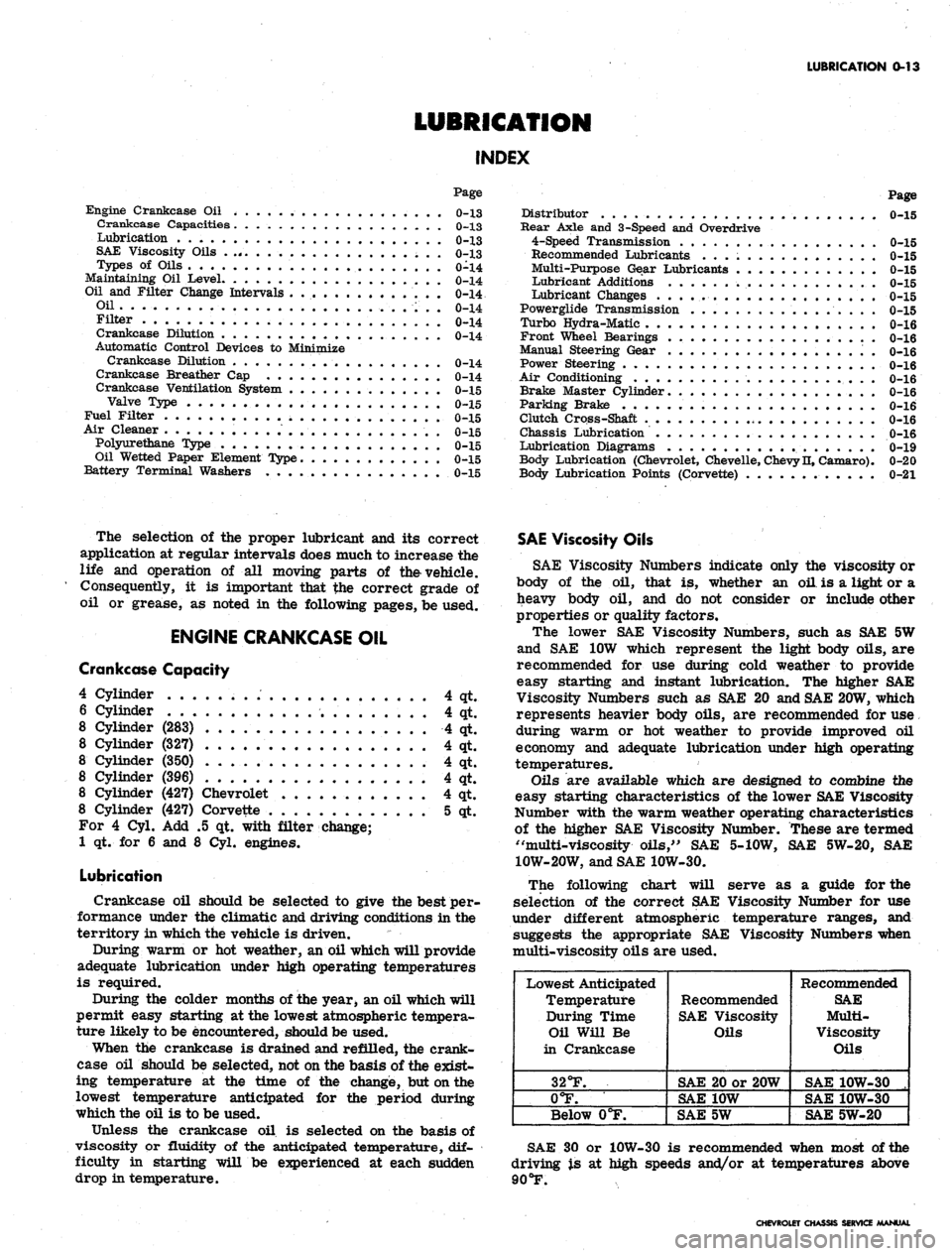
LUBRICATION 0-13
LUBRICATION
INDEX
Page
Engine Crankcase Oil . 0-13
Crankcase Capacities. . 0-13
Lubrication . ,
•
o-13
SAE Viscosity Oils 0-13
Types of Oils 0-14
Maintaining Oil Level 0-14
Oil and Filter Change Intervals 0-14
Oil.
. . ...:.. 0-14
Filter o-14
Crankcase Dilution . 0-14
Automatic Control Devices to Minimize
Crankcase Dilution 0-14
Crankcase Breather Cap 0-14
Crankcase Ventilation System 0-15
Valve Type 0-15
Fuel Filter 0-15
Air Cleaner . 0-15
Polyurethane Type 0-15
Oil Wetted Paper Element Type 0-15
Battery Terminal Washers 0-15
Page
Distributor 0-15
Rear Axle and 3-Speed and Overdrive
4-Speed Transmission 0-15
Recommended Lubricants 0-15
Multi-Purpose Gear Lubricants 0-15
Lubricant Additions 0-15
Lubricant Changes 0-15
Powerglide Transmission 0-15
Turbo Hydra-Matic 0-16
Front Wheel Bearings 0-16
Manual Steering Gear . . . . 0-16
Power Steering 0-16
Air Conditioning 0-16
Brake Master Cylinder. 0-16
Parking Brake 0-16
Clutch Cross-Shaft , 0-16
Chassis Lubrication 0-16
Lubrication Diagrams . . 0-19
Body Lubrication (Chevrolet, Chevelle, Chevy n, Camaro). 0-20
Body Lubrication Points (Corvette) . 0-21
The selection of the proper lubricant and its correct
application at regular intervals does much to increase the
life and operation of all moving parts of the vehicle.
Consequently, it is important that the correct grade of
oil or grease, as noted in the following pages, be used.
ENGINE CRANKCASE OIL
Crankcase Capacity
4 Cylinder 4 qt.
6 Cylinder 4 qt.
8 Cylinder (283) 4 qt.
8 Cylinder (327) 4 qt.
8 Cylinder (350) 4 qt.
8 Cylinder (396) 4 qt.
8 Cylinder (427) Chevrolet 4 qt.
8 Cylinder (427) Corvette 5 qt.
For 4 Cyl. Add .5 qt. with filter change;
1 qt. for 6 and 8 Cyl. engines.
Lubrication
Crankcase oil should be selected to give the best per-
formance under the climatic and driving conditions in the
territory in which the vehicle is driven.
During warm or hot weather, an oil which will provide
adequate lubrication under high operating temperatures
is required.
During the colder months of the year* an oil which will
permit easy starting at the lowest atmospheric tempera-
ture likely to be encountered, should be used.
When the crankcase is drained and refilled, the crank-
case oil should be selected, not on the basis of the exist-
ing temperature at the time of the change, but on the
lowest temperature anticipated for the period during
which the oil is to be used.
Unless the crankcase oil is selected on the basis of
viscosity or fluidity of the anticipated temperature, dif-
ficulty in starting will be experienced at each sudden
drop in temperature.
SAE Viscosity Oils
SAE Viscosity Numbers indicate only the viscosity or
body of the oil, that is, whether an oil is a light or a
heavy body oil, and do not consider or include other
properties or quality factors.
The lower SAE Viscosity Numbers, such as SAE 5W
and SAE 10W which represent the light body oils, are
recommended for use during cold weather to provide
easy starting and instant lubrication. The higher SAE
Viscosity Numbers such as SAE 20 and SAE 20W, which
represents heavier body oils, are recommended for use
during warm or hot weather to provide improved oil
economy and adequate lubrication under high operating
temperatures.
Oils are available which are designed to combine the
easy starting characteristics of the lower SAE Viscosity
Number with the warm weather operating characteristics
of the higher SAE Viscosity Number. These are termed
"multi-viscosity oils," SAE 5-10W, SAE 5W-20, SAE
10W-20W, and SAE 10W-30.
The following chart will serve as a guide for the
selection of the correct SAE Viscosity Number for use
under different atmospheric temperature ranges, and
suggests the appropriate SAE Viscosity Numbers when
multi-viscosity oils are used.
Lowest Anticipated
Temperature
During Time
Oil Will Be
in Crankcase
32°F.
0°F.
Below 0°F.
Recommended
SAE Viscosity
Oils
SAE 20 or 20W
SAE 10W
SAE 5W
Recommended
SAE
Multi-
Viscosity
Oils
SAE 10W-30 .
SAE 10W-30
SAE 5W-20
SAE 30 or 10W-30 is recommended when most of the
driving is at high speeds and/or at temperatures above
90
°F.
CHEVROLET CHASSIS SERVICE MANUAL
Page 16 of 659
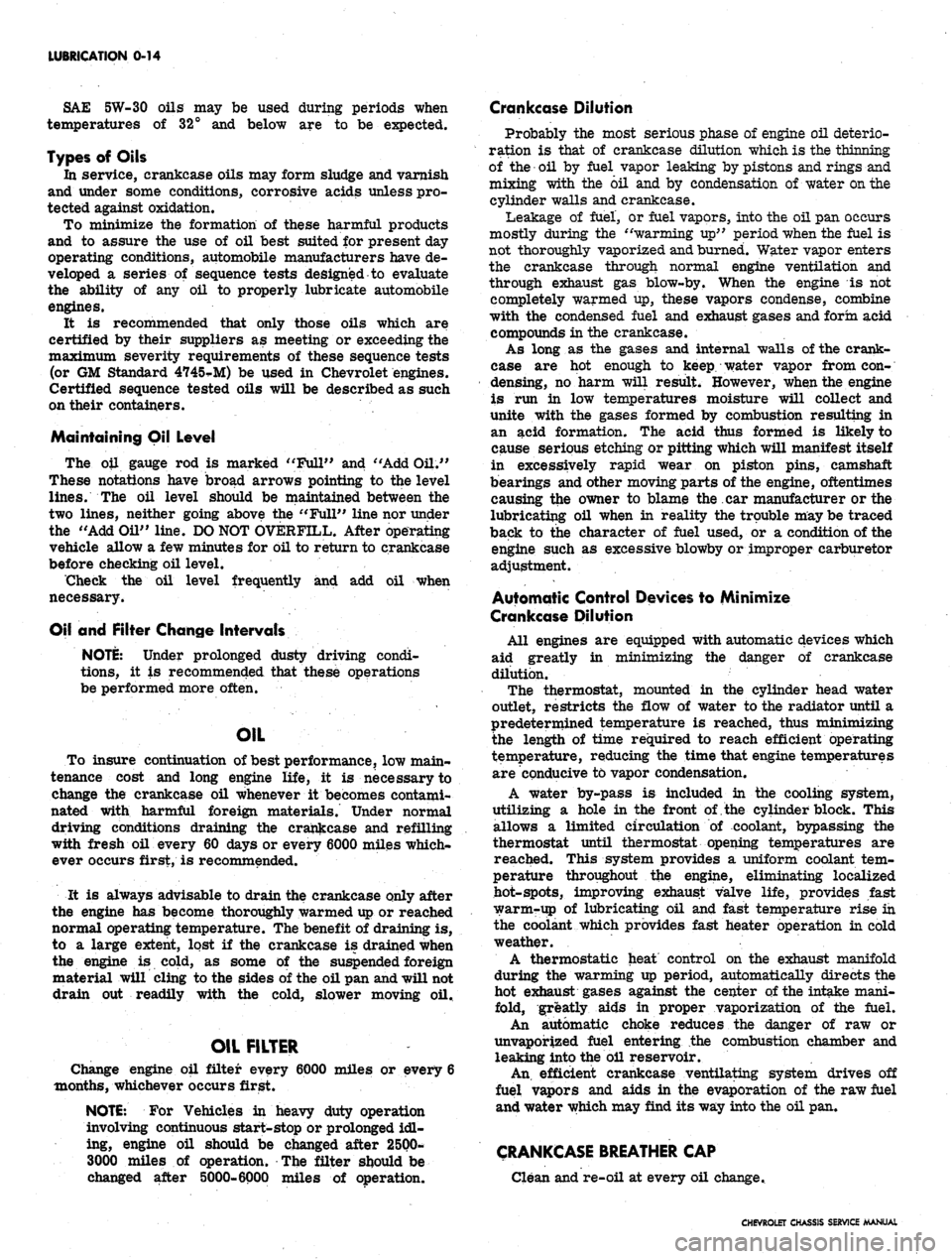
LUBRICATION 0-14
SAE 5W-30 oils may be used during periods when
temperatures of 32° and below are to be expected.
Types of Oils
In service, crankcase oils may form sludge and varnish
and under some conditions, corrosive acids unless pro-
tected against oxidation.
To minimize the formation of these harmful products
and to assure the use of oil best suited for present day
operating conditions, automobile manufacturers have de-
veloped a series of sequence tests designed to evaluate
the ability of any oil to properly lubricate automobile
engines.
It is recommended that only those oils which are
certified by their suppliers as meeting or exceeding the
maximum severity requirements of these sequence tests
(or GM Standard 4745-M) be used in Chevrolet engines.
Certified sequence tested oils will be described as such
on their containers.
Maintaining Oil Level
The oil gauge rod is marked "Full" and "Add Oil."
These notations have broad arrows pointing to the level
lines.
The oil level should be maintained between the
two lines, neither going above the "Full" line nor under
the "Add Oil" line. DO NOT OVERFILL. After operating
vehicle allow a few minutes for oil to return to crankcase
before checking oil level.
Check the oil level frequently and add oil when
necessary.
Oil and Filter Change Intervals
NOTE:
Under prolonged dusty driving condi-
tions,
it is recommended that these operations
be performed more often.
OIL
To insure continuation of best performance, low main-
tenance cost and long engine life, it is necessary to
change the crankcase oil whenever it becomes contami-
nated with harmful foreign materials. Under normal
driving conditions draining the crankcase and refilling
with fresh oil every 60 days or every 6000 miles which-
ever occurs first, is recommended.
It is always advisable to drain the crankcase only after
the engine has become thoroughly warmed up or reached
normal operating temperature. The benefit of draining is,
to a large extent, lost if the crankcase is drained when
the engine is cold, as some of the suspended foreign
material will cling to the sides of the oil pan and will not
drain out readily with the cold, slower moving oil.
OIL FILTER
Change engine oil filter every 6000 miles or every 6
months, whichever occurs first.
NOTE:
For Vehicles in heavy duty operation
involving continuous start-stop or prolonged idl-
ing, engine oil should be changed after 2500-
3000 miles of operation. The filter should be
changed after 5000-6000 miles of operation.
Crankcase Dilution
Probably the most serious phase of engine oil deterio-
ration is that of crankcase dilution which is the thinning
of the oil by fuel vapor leaking by pistons and rings and
mixing with the oil and by condensation of water on the
cylinder walls and crankcase.
Leakage of fuel, or fuel vapors, into the oil pan occurs
mostly during the "warming up" period when the fuel is
not thoroughly vaporized and burned. Water vapor enters
the crankcase through normal engine ventilation and
through exhaust gas blow-by. When the engine is not
completely warmed up, these vapors condense, combine
with the condensed fuel and exhaust gases and form acid
compounds in the crankcase.
As long as the gases and internal walls of the crank-
case are hot enough to keep water vapor from con-
densing, no harm will result. However, when the engine
is run in low temperatures moisture will collect and
unite with the gases formed by combustion resulting in
an acid formation. The acid thus formed is likely to
cause serious etching or pitting which will manifest itself
in excessively rapid wear on piston pins, camshaft
bearings and other moving parts of the engine, oftentimes
causing the owner to blame the car manufacturer or the
lubricating oil when in reality the trouble may be traced
back to the character of fuel used, or a condition of the
engine such as excessive blowby or improper carburetor
adjustment.
Automatic Control Devices to Minimize
Crankcase Dilution
All engines are equipped with automatic devices which
aid greatly in minimizing the danger of crankcase
dUution.
The thermostat, mounted in the cylinder head water
outlet, restricts the flow of water to the radiator until a
predetermined temperature is reached, thus minimizing
the length of time required to reach efficient operating
temperature, reducing the time that engine temperatures
are conducive to vapor condensation.
A water by-pass is included in the cooling system,
utilizing a hole in the front of, the cylinder block. This
allows a limited circulation of coolant, bypassing the
thermostat until thermostat opening temperatures are
reached. This system provides a uniform coolant tem-
perature throughout the engine, eliminating localized
hot-spots, improving exhaust valve life, provides fast
warmrup of lubricating oil and fast temperature rise in
the coolant which provides fast heater operation in cold
weather.
A thermostatic heat control on the exhaust manifold
during the warming up period, automatically directs the
hot exhaust gases against the center of the intake mani-
fold, greatly aids in proper vaporization of the fuel.
An automatic choke reduces the danger of raw or
unvaporized fuel entering the combustion chamber and
leaking into the oil reservoir.
An.
efficient crankcase ventilating system drives off
fuel vapors and aids in the evaporation of the raw fuel
and water which may find its way into the oil pan.
CRANKCASE BREATHER CAP
Clean and re-oil at every oil change..
CHEVROLET CHASSIS SERVICE MANUAL
Page 17 of 659
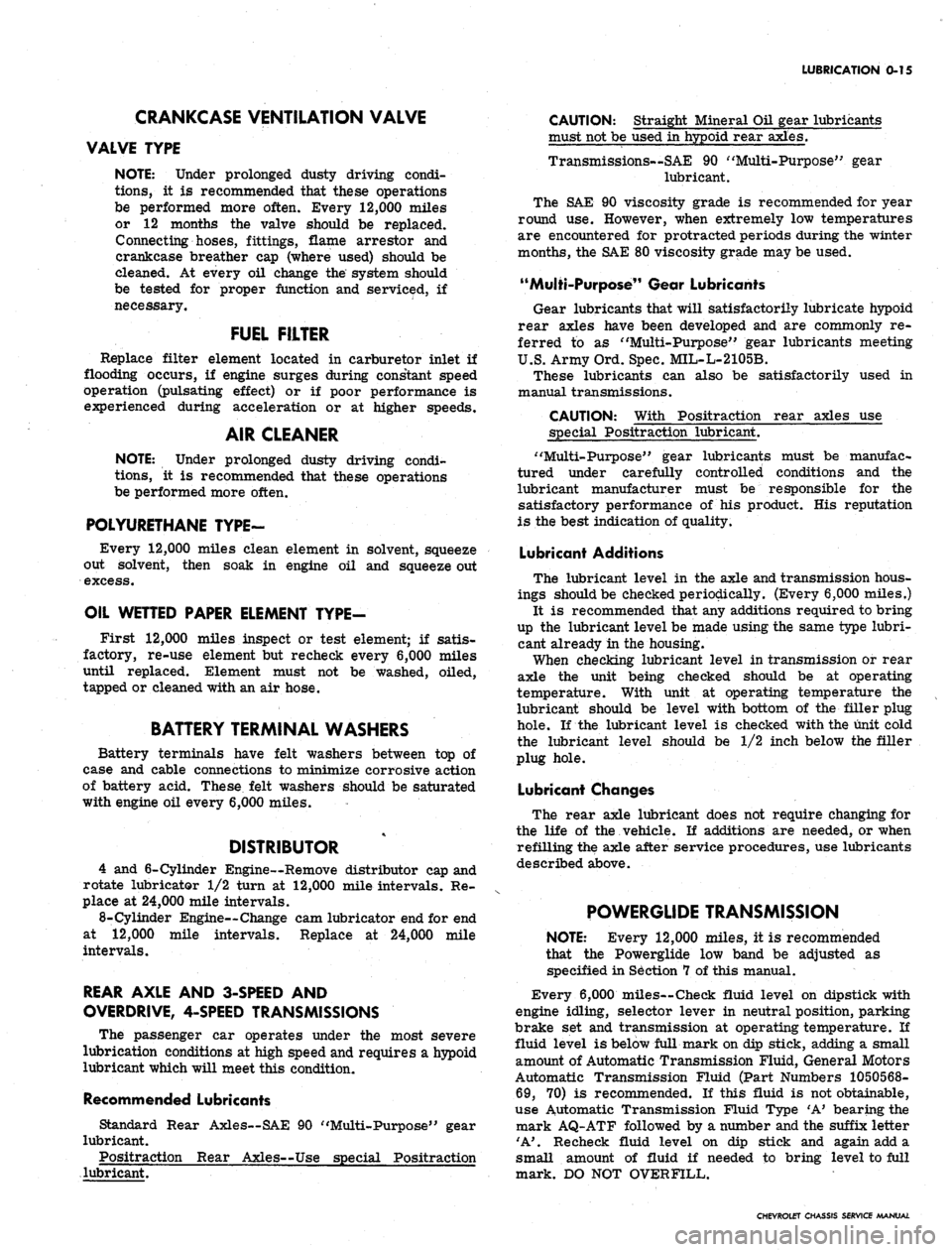
LUBRICATION 0-15
CRANKCASE VENTILATION VALVE
VALVE TYPE
NOTE: Under prolonged dusty driving condi-
tions,
it is recommended that these operations
be performed more often. Every 12,000 miles
or 12 months the valve should be replaced.
Connecting hoses, fittings, flame arrestor and
crankcase breather cap (where used) should be
cleaned. At every oil change the system should
be tested for proper function and serviced, if
necessary.
FUEL FILTER
Replace filter element located in carburetor inlet if
flooding occurs, if engine surges during constant speed
operation (pulsating effect) or if poor performance is
experienced during acceleration or at higher speeds.
AIR CLEANER
NOTE: Under prolonged dusty driving condi-
tions,
it is recommended that these operations
be performed more often.
POLYURETHANE TYPE-
Every 12,000 miles clean element in solvent, squeeze
out solvent, then soak in engine oil and squeeze out
excess.
OIL WETTED PAPER ELEMENT TYPE-
First 12,000 miles inspect or test element; if satis-
factory, re-use element but recheck every 6,000 miles
until replaced. Element must not be washed, oiled,
tapped or cleaned with an air hose.
BATTERY TERMINAL WASHERS
Battery terminals have felt washers between top of
case and cable connections to minimize corrosive action
of battery acid. These felt washers should be saturated
with engine oil every 6,000 miles.
DISTRIBUTOR
4 and 6-Cylinder Engine—Remove distributor cap and
rotate lubricator 1/2 turn at 12,000 mile intervals. Re-
place at 24,000 mile intervals.
8-Cylinder Engine—Change cam lubricator end for end
at 12,000 mile intervals. Replace at 24,000 mile
intervals.
REAR AXLE AND 3-SPEED AND
OVERDRIVE, 4-SPEED TRANSMISSIONS
The passenger car operates under the most severe
lubrication conditions at high speed and requires a hypoid
lubricant which will meet this condition.
Recommended Lubricants
Standard Rear Axles—SAE 90 "Multi-Purpose" gear
lubricant.
Positraction Rear Axles—Use special Positraction
lubricant.
CAUTION: Straight Mineral Oil gear lubricants
must not be used in hypoid rear axles.
Transmissions—SAE 90 "Multi-Purpose" gear
lubricant.
The SAE 90 viscosity grade is recommended for year
round use. However, when extremely low temperatures
are encountered for protracted periods during the winter
months, the SAE 80 viscosity grade may be used.
"Multi-Purpose" Gear Lubricants
Gear lubricants that will satisfactorily lubricate hypoid
rear axles have been developed and are commonly re-
ferred to as ' 'Multi-Purpose" gear lubricants meeting
U.S.
Army Ord. Spec. MIL-L-2105B.
These lubricants can also be satisfactorily used in
manual transmissions.
CAUTION: With Positraction rear axles use
special Positraction lubricant.
"Multi-Purpose" gear lubricants must be manufac-
tured under carefully controlled conditions and the
lubricant manufacturer must be responsible for the
satisfactory performance of his product. His reputation
is the best indication of quality.
Lubricant Additions
The lubricant level in the axle and transmission hous-
ings should be checked periodically. (Every 6,000 miles.)
It is recommended that any additions required to bring
up the lubricant level be made using the same type lubri-
cant already in the housing.
When checking lubricant level in transmission or rear
axle the unit being cheeked should be at operating
temperature. With unit at operating temperature the
lubricant should be level with bottom of the filler plug
hole.
If the lubricant level is checked with the unit cold
the lubricant level should be 1/2 inch below the filler
plug hole.
Lubricant Changes
The rear axle lubricant does not require changing for
the life of the vehicle. If additions are needed, or when
refilling the axle after service procedures, use lubricants
described above.
POWERGLIDE TRANSMISSION
NOTE: Every 12,000 miles, it is recommended
that the Powerglide low band be adjusted as
specified in Section 7 of this manual.
Every 6,000 miles--Check fluid level on dipstick with
engine idling, selector lever in neutral position, parking
brake set and transmission at operating temperature. If
fluid level is below full mark on dip stick, adding a small
amount of Automatic Transmission Fluid, General Motors
Automatic Transmission Fluid (Part Numbers 1050568-
69,
70) is recommended. If this fluid is not obtainable,
use Automatic Transmission Fluid Type 'A' bearing the
mark AQ-ATF followed by a number and the suffix letter
'A'.
Recheck fluid level on dip stick and again add a
small amount of fluid if needed to bring level to full
mark. DO NOT OVERFILL.
CHEVROLET CHASSIS SERVICE MANUAL
Page 19 of 659
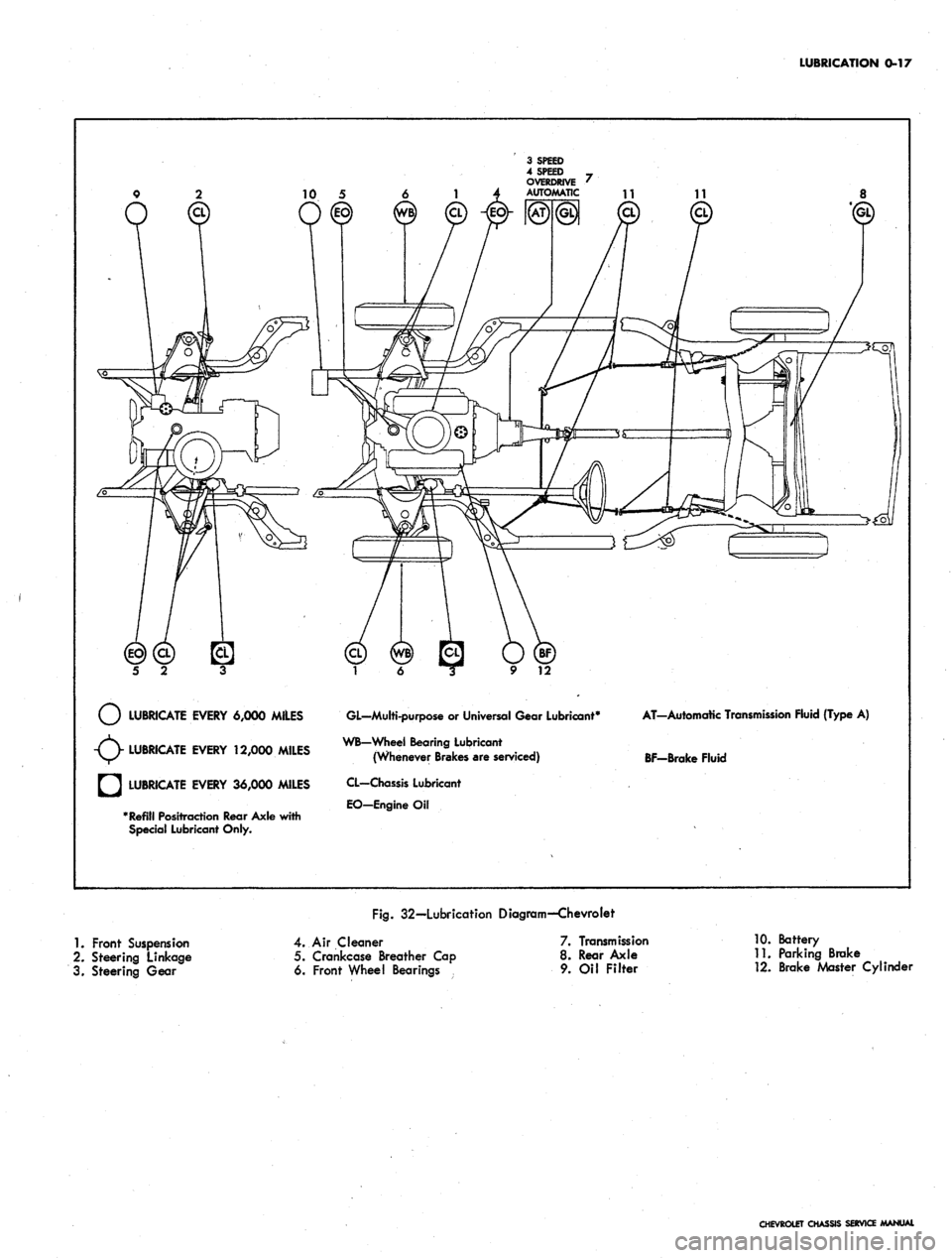
LUBRICATION 0-17
LUBRICATE EVERY 6,000 MILES
LUBRICATE EVERY 12,000 MILES
LUBRICATE EVERY 36,000 MILES
Refill Positraction Rear Axle with
Special Lubricant Only.
GL—Multi-purpose
or
Universal Gear Lubricant4
WB-Wheel Bearing Lubricant
(Whenever Brakes are serviced)
CL—Chassis Lubricant
EO-EngineOil
AT-Automatic Transmission Fluid {Type
A)
BF-Brake Fluid
Fig.
32—Lubrication Diagram—Chevrolet
1.
Front Suspension
2.
Steering Linkage
3. Steering Gear
4.
Air Cleaner
5. Crankcase Breather Cap
6. Front Wheel Bearings
7. Transmission
8. Rear Axle
9. Oil Filter
10.
Battery
11.
Parking Brake
12.
Brake Master Cylinder
CHEVROLET CHASSIS SERVICE MANUAL
Page 21 of 659
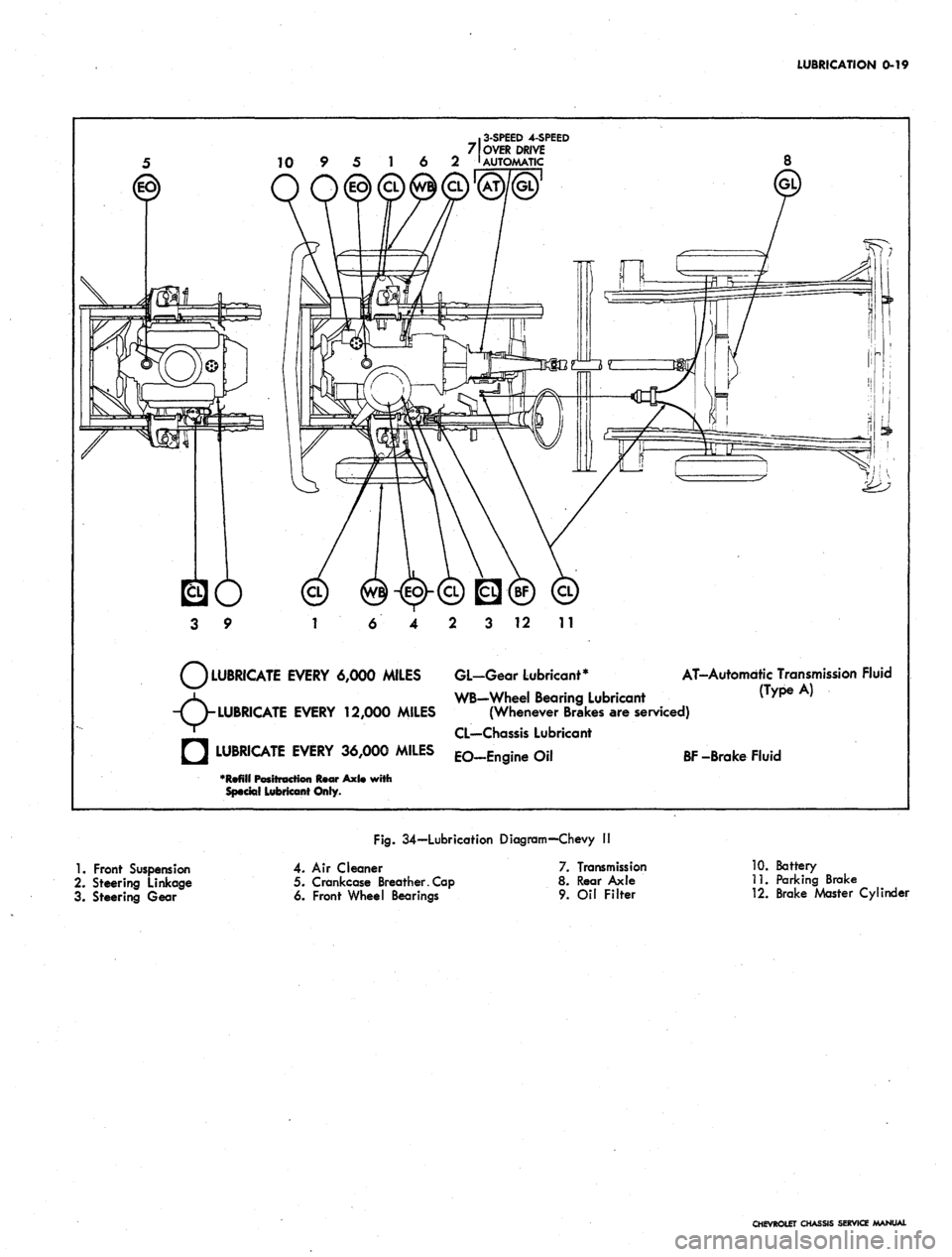
LUBRICATION
0-19
.
3-SPEED
4-SPEED
7 OVER DRIVE
10 9 5 1 6 2 '
AUTOMATIC
3 12 11
LUBRICATE EVERY 6,000 MILES GL-Gear Lubricant*
WB-Wheel Bearing Lubricant
(Wh Bk
AT-Automdtic Transmission Fluid
^ WB-Wheel Bearing Lubricant (Type A)
-TV
LUBRICATE
EVERY 12,000 MILES (Whenever Brakes are serviced)
' CL—Chassis Lubricant
• LUBRICATE EVERY 36,000 MILES EO_Engine Oil
BF
-Brake Fluid
•Refill Positt
Special Lubricant Only.
Axl«
with
1.
Front Suspension
2.
Steering Linkage
3. Steering Gear
Fig.
34—Lubrication Diagram—Chevy I!
4. Air Cleaner
5. Crankcase Breather. Cap
6. Front Wheel Bearings
7. Transmission
8. Rear Axle
9.
Oil Filter
10.
Battery
11.
Parking Brake
12.
Brake Master Cylinder
CHEVROLET CHASSIS SERVICE MANUAL